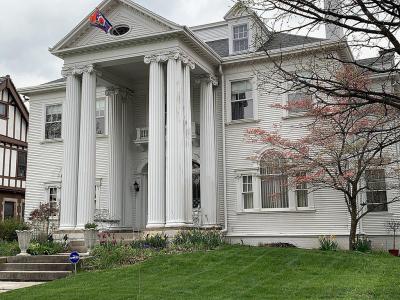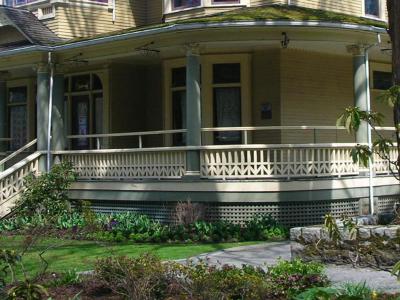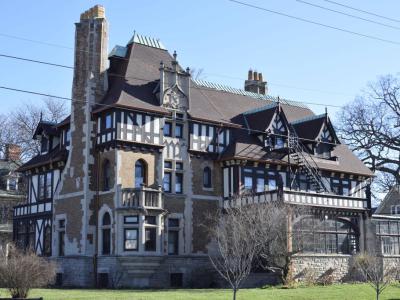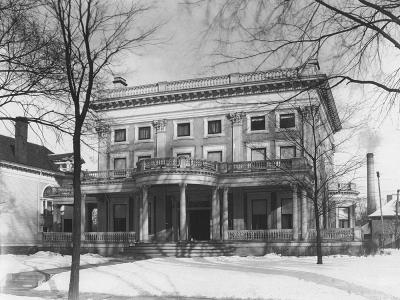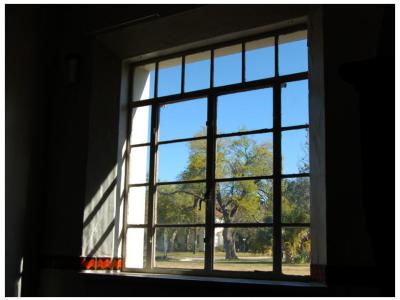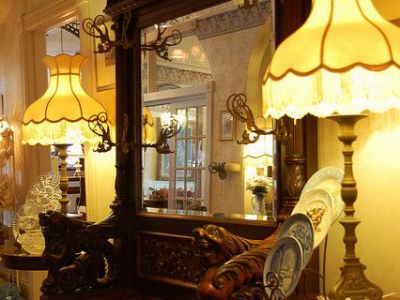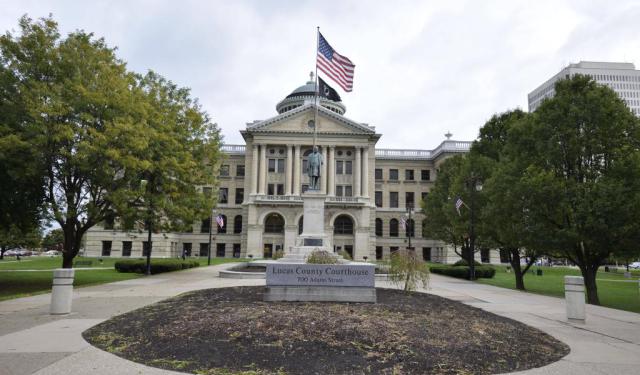
Historical Houses Tour (Self Guided), Toledo
If you want to visit the place that has kept alive the spirit of fine 19th-century architecture, witness a life of glamor and elegance, and experience the style and wealth of the mighty of this world, then the Old West End neighborhood in Toledo, Ohio, is your ultimate destination. Indeed, this historic district (listed on the National Register of Historic Places) is "the largest neighborhood of late Victorian, Edwardian, and Arts & Crafts homes east of the Mississippi." Each of the notable residences here reflects a unique slice of local history and architectural heritage.
Among them is the Julian H Tyler House, a refined property distinguished by its harmonious blend of 18th-century American Georgian and diluted Palladian styles, combining symmetry and classical influences. The Frederick O Paddock House, characterized by its Queen Anne style, symbolizes late 19th-century opulence, with its intricate woodwork and a complex blend of shingle, sandstone, and brick, together creating a visually compelling and textured exterior.
The John N Willys House, a meticulously restored 1901 mansion, features classic English Tudor elements outside and an opulent interior, offering a glimpse into early 20th-century elite living. In contrast, the Edward V Brucker House is a prime example of Gothic Revival architecture, built in 1897, reflecting the success and community influence of its original owners, prominent figures in Toledo's civic and cultural spheres.
The Edward D Libbey House, a National Historical Landmark, showcases Colonial Revival, boasting grand interiors adorned with exquisite woodwork, stained glass, and ornate details, reflecting the philanthropic spirit of its namesake, who contributed significantly to Toledo's cultural and educational institutions. Meanwhile, the Clarence Brown House, with its Tudor Revival charm, exemplifies the elegance and craftsmanship prevalent in early 20th-century residential design.
Visiting these and other historical homes featured in this walk offers a journey through Toledo's architectural past but also a deeper understanding of the city's cultural legacy and community development. So, given the opportunity, plan your visit and explore Toledo's living demonstration of style, grace, and beauty using our self-guided tour!
Among them is the Julian H Tyler House, a refined property distinguished by its harmonious blend of 18th-century American Georgian and diluted Palladian styles, combining symmetry and classical influences. The Frederick O Paddock House, characterized by its Queen Anne style, symbolizes late 19th-century opulence, with its intricate woodwork and a complex blend of shingle, sandstone, and brick, together creating a visually compelling and textured exterior.
The John N Willys House, a meticulously restored 1901 mansion, features classic English Tudor elements outside and an opulent interior, offering a glimpse into early 20th-century elite living. In contrast, the Edward V Brucker House is a prime example of Gothic Revival architecture, built in 1897, reflecting the success and community influence of its original owners, prominent figures in Toledo's civic and cultural spheres.
The Edward D Libbey House, a National Historical Landmark, showcases Colonial Revival, boasting grand interiors adorned with exquisite woodwork, stained glass, and ornate details, reflecting the philanthropic spirit of its namesake, who contributed significantly to Toledo's cultural and educational institutions. Meanwhile, the Clarence Brown House, with its Tudor Revival charm, exemplifies the elegance and craftsmanship prevalent in early 20th-century residential design.
Visiting these and other historical homes featured in this walk offers a journey through Toledo's architectural past but also a deeper understanding of the city's cultural legacy and community development. So, given the opportunity, plan your visit and explore Toledo's living demonstration of style, grace, and beauty using our self-guided tour!
How it works: Download the app "GPSmyCity: Walks in 1K+ Cities" from Apple App Store or Google Play Store to your mobile phone or tablet. The app turns your mobile device into a personal tour guide and its built-in GPS navigation functions guide you from one tour stop to next. The app works offline, so no data plan is needed when traveling abroad.
Historical Houses Tour Map
Guide Name: Historical Houses Tour
Guide Location: USA » Toledo (See other walking tours in Toledo)
Guide Type: Self-guided Walking Tour (Sightseeing)
# of Attractions: 11
Tour Duration: 2 Hour(s)
Travel Distance: 1.8 Km or 1.1 Miles
Author: AliceM
Sight(s) Featured in This Guide:
Guide Location: USA » Toledo (See other walking tours in Toledo)
Guide Type: Self-guided Walking Tour (Sightseeing)
# of Attractions: 11
Tour Duration: 2 Hour(s)
Travel Distance: 1.8 Km or 1.1 Miles
Author: AliceM
Sight(s) Featured in This Guide:
- Julian H. Tyler House
- Frederick O. Paddock House
- John N. Willys House
- Edward V. Brucker House
- Edward D. Libbey House
- Clarence Brown House
- Julius G. Lamson House
- Stranahan-Rothschild House
- Leeper-Geddes House
- Moses G. Bloch House
- Wright-Wilmington House
1) Julian H. Tyler House
The Julian H. Tyler House, constructed in 1897 for Judge Julian H. Tyler, a prominent partner in a Toledo law firm, stands as a distinguished example of hybrid architectural styles. Located in Toledo's Old West End district, the design of this house was derived from 18th-century American Georgian sources combined with the diluted Palladianism that characterized the work of the notable New York firm McKim, Mead & White. The result is a residence that blends the elegance and symmetry of Georgian architecture with the classical influences of Palladian design.
The facade of the Julian H. Tyler House is a study in balanced simplicity. At the center, the entrance is flanked by two symmetrical windows, a hallmark of Georgian architecture. This symmetry is complemented by the Palladian-inspired portico, a porch with a roof supported by columns, which adds a touch of classical grandeur without overwhelming the overall aesthetic. The house's straight lines and understated elegance provide a striking contrast to the more ornate Baroque structures in the surrounding area, offering a refreshing simplicity that enhances its architectural significance.
The integration of these two architectural styles creates a harmonious and refined appearance. The Georgian elements, characterized by their symmetry and proportion, are beautifully interwoven with the Palladian features, notably the portico, which adds depth and a sense of historical continuity. This combination underscores the sophistication and thoughtfulness of the design, making the Julian H. Tyler House a notable example of late 19th-century architectural trends that sought to blend tradition with innovation.
The facade of the Julian H. Tyler House is a study in balanced simplicity. At the center, the entrance is flanked by two symmetrical windows, a hallmark of Georgian architecture. This symmetry is complemented by the Palladian-inspired portico, a porch with a roof supported by columns, which adds a touch of classical grandeur without overwhelming the overall aesthetic. The house's straight lines and understated elegance provide a striking contrast to the more ornate Baroque structures in the surrounding area, offering a refreshing simplicity that enhances its architectural significance.
The integration of these two architectural styles creates a harmonious and refined appearance. The Georgian elements, characterized by their symmetry and proportion, are beautifully interwoven with the Palladian features, notably the portico, which adds depth and a sense of historical continuity. This combination underscores the sophistication and thoughtfulness of the design, making the Julian H. Tyler House a notable example of late 19th-century architectural trends that sought to blend tradition with innovation.
2) Frederick O. Paddock House
The Frederick O. Paddock House, built in 1892, is a stunning example of classical style architecture infused with rich decorative elements that make it a standout mansion in Toledo. This grand residence showcases an intricate blend of shingle, sandstone, and brick, materials that together create a visually compelling and textured exterior. The choice of materials not only enhances the aesthetic appeal of the house but also underscores the craftsmanship and attention to detail that went into its construction.
One of the most distinctive features of the Frederick O. Paddock House is its high tower, which adds a vertical dimension to the building and serves as a focal point of its design. This tower, combined with the sun lounge that wraps around the house, provides a blend of both grandeur and leisurely elegance. The sun lounge is particularly notable for its ability to flood the interior spaces with natural light, creating a warm and inviting atmosphere that contrasts beautifully with the robust exterior.
The architecture of the Paddock House is further distinguished by its asymmetrical gable walls, which introduce an element of visual interest and complexity. These gables break from the traditional symmetry often associated with classical architecture, giving the house a unique and dynamic silhouette. The asymmetry not only enhances the aesthetic appeal but also speaks to the architectural trends of the late 19th century, which began to embrace more eclectic and varied forms.
One of the most distinctive features of the Frederick O. Paddock House is its high tower, which adds a vertical dimension to the building and serves as a focal point of its design. This tower, combined with the sun lounge that wraps around the house, provides a blend of both grandeur and leisurely elegance. The sun lounge is particularly notable for its ability to flood the interior spaces with natural light, creating a warm and inviting atmosphere that contrasts beautifully with the robust exterior.
The architecture of the Paddock House is further distinguished by its asymmetrical gable walls, which introduce an element of visual interest and complexity. These gables break from the traditional symmetry often associated with classical architecture, giving the house a unique and dynamic silhouette. The asymmetry not only enhances the aesthetic appeal but also speaks to the architectural trends of the late 19th century, which began to embrace more eclectic and varied forms.
3) John N. Willys House
The John N. Willys House, built in 1901, is a stunning example of English Tudor architecture, known for its luxury and meticulous attention to detail. This mansion has been restored to its original grandeur by Michael and Ellen Murray, who have worked diligently to preserve its historical integrity. The house's exterior features classic Tudor elements such as half-timbering, a French mansard roof, and French Gothic dormers, which together create a visually striking and pretentious facade. Additionally, the Tillinghast coat-of-arms, with its motto carved in stone, adds a touch of medieval charm, highlighting the building's grand proportions and intricate details.
Inside, the John N. Willys House continues to impress with its opulent interior design. The first floor boasts a beautiful living room adorned with a gold-leafed ceiling hall, reflecting the luxurious tastes of the era in which it was built. The impressive dining room is a highlight of the home, featuring rich wooden panels and a unique chandelier that exudes elegance and sophistication. These rooms provide a glimpse into the lifestyle of the wealthy elite of the early 20th century, showcasing the architectural and decorative prowess of the time.
The house also includes a well-appointed library, wainscoted with intricate decorative elements that add to its historical charm. Despite its age, the library is equipped with a modern air ventilating system, ensuring comfort while maintaining its period authenticity. This blend of historical detail and modern convenience makes the John N. Willys House a unique and highly desirable residence, embodying both the grandeur of the past and the practicality of the present.
Inside, the John N. Willys House continues to impress with its opulent interior design. The first floor boasts a beautiful living room adorned with a gold-leafed ceiling hall, reflecting the luxurious tastes of the era in which it was built. The impressive dining room is a highlight of the home, featuring rich wooden panels and a unique chandelier that exudes elegance and sophistication. These rooms provide a glimpse into the lifestyle of the wealthy elite of the early 20th century, showcasing the architectural and decorative prowess of the time.
The house also includes a well-appointed library, wainscoted with intricate decorative elements that add to its historical charm. Despite its age, the library is equipped with a modern air ventilating system, ensuring comfort while maintaining its period authenticity. This blend of historical detail and modern convenience makes the John N. Willys House a unique and highly desirable residence, embodying both the grandeur of the past and the practicality of the present.
4) Edward V. Brucker House
The Edward V. Brucker House, constructed in 1897, is a notable example of Gothic Revival architecture. Built for Edward V. Brucker, the founder and president of the Karavan Coffee Company, the house reflects the success and social prominence of its original owner. Brucker was not only a successful businessman but also a significant figure in the community, contributing to the construction of the Rosary Cathedral as a member of its original building committee. His wife, Mrs. Brucker, was equally active in civic and cultural affairs, serving as the first president of the Toledo Council of Catholic Charities. The Brucker family resided in this elegant home until the latter half of the 20th century.
The interior of the Brucker House is richly decorated, featuring intricate mosaics and oak floors and staircases. The vestibule, with its original marbled mosaic tile floor and leaded glass sidelights, leads into the front hall where a gas fireplace surrounded by mosaic tile adds a touch of warmth and elegance. All the woodwork in the front hall and stairway, originally painted, has been meticulously stripped to reveal the beautiful oak underneath. This attention to detail extends throughout the house, showcasing the craftsmanship of the period.
On the first floor, the house boasts four fireplaces, enhancing its cozy and luxurious ambiance. The dining room, accessible through pocket doors from the hall, features a wood-burning fireplace and a built-in mahogany buffet with leaded glass doors. Opposite the buffet is the original built-in linen and silver cabinet, a highlight of the interior. The living room, with its original brass chandelier, fireplace, and built-in window seat, opens into a sunroom, thought to have been enclosed after the home was built. The kitchen has been completely renovated and enlarged, blending modern convenience with the home's historic charm.
The upper floors of the Brucker House continue to reflect its grandeur. The second floor contains five bedrooms and two full baths, while the third floor offers an additional bedroom. Throughout the home, the rich history of the Brucker family is palpable, from the marbled mosaic tiles in the vestibule to the oak woodwork in the front hall.
The interior of the Brucker House is richly decorated, featuring intricate mosaics and oak floors and staircases. The vestibule, with its original marbled mosaic tile floor and leaded glass sidelights, leads into the front hall where a gas fireplace surrounded by mosaic tile adds a touch of warmth and elegance. All the woodwork in the front hall and stairway, originally painted, has been meticulously stripped to reveal the beautiful oak underneath. This attention to detail extends throughout the house, showcasing the craftsmanship of the period.
On the first floor, the house boasts four fireplaces, enhancing its cozy and luxurious ambiance. The dining room, accessible through pocket doors from the hall, features a wood-burning fireplace and a built-in mahogany buffet with leaded glass doors. Opposite the buffet is the original built-in linen and silver cabinet, a highlight of the interior. The living room, with its original brass chandelier, fireplace, and built-in window seat, opens into a sunroom, thought to have been enclosed after the home was built. The kitchen has been completely renovated and enlarged, blending modern convenience with the home's historic charm.
The upper floors of the Brucker House continue to reflect its grandeur. The second floor contains five bedrooms and two full baths, while the third floor offers an additional bedroom. Throughout the home, the rich history of the Brucker family is palpable, from the marbled mosaic tiles in the vestibule to the oak woodwork in the front hall.
5) Edward D. Libbey House
The Edward D. Libbey House, also known as the Libbey-Chudy-Perkins House, is an architectural marvel. Built in 1885, this Colonial Revival-style estate spans 10,000 square feet and is renowned for its historical and aesthetic significance. Over its 125-year history, the house has changed ownership numerous times, yet it consistently elicits admiration from all who visit. The meticulous design and preservation of its interior evoke a sense of timeless elegance and charm, reminiscent of scenes from classic films.
Designated as a National Historical Landmark of the USA, the Libbey House stands as a testament to the craftsmanship and architectural sophistication of the late 19th century. The two years of careful construction and design have resulted in a home that perfectly embodies Colonial Revival style, with a harmonious blend of wood, glass, and stucco moldings. Visitors are greeted by a 30-foot reception hall featuring a grand cherry wood staircase and a large stained glass bay, setting the tone for the home's luxurious interior. Adjacent to the reception hall are a music room, a mahogany parlor, and an ornately paneled dining room adorned with hand-carved lions' heads.
Throughout the house, one can find exquisite details such as dentil, egg and dart, and bead and reel moldings, as well as Doric, Ionic, and Corinthian columns. The use of cherry, oak, and mahogany in hand-carved woodwork, pillars, mantles, and built-in bookcases showcases the home's commitment to intricate craftsmanship. The stained, leaded, and curved glass windows add to the grandeur, while one of the many fireplaces features hand-painted Delft tiles imported from the Netherlands. The third floor, initially intended for servants, has been transformed into bedrooms and an office, maintaining the home's functional and historical integrity.
The Libbey House also boasts luxurious bathroom features, including pedestal lavatories, oversized clawfoot tubs, and a marble shower with full body spray. An underground wine cellar and many original gas light fixtures, most of which have been converted to electric, highlight the home's blend of historical charm and modern convenience.
Designated as a National Historical Landmark of the USA, the Libbey House stands as a testament to the craftsmanship and architectural sophistication of the late 19th century. The two years of careful construction and design have resulted in a home that perfectly embodies Colonial Revival style, with a harmonious blend of wood, glass, and stucco moldings. Visitors are greeted by a 30-foot reception hall featuring a grand cherry wood staircase and a large stained glass bay, setting the tone for the home's luxurious interior. Adjacent to the reception hall are a music room, a mahogany parlor, and an ornately paneled dining room adorned with hand-carved lions' heads.
Throughout the house, one can find exquisite details such as dentil, egg and dart, and bead and reel moldings, as well as Doric, Ionic, and Corinthian columns. The use of cherry, oak, and mahogany in hand-carved woodwork, pillars, mantles, and built-in bookcases showcases the home's commitment to intricate craftsmanship. The stained, leaded, and curved glass windows add to the grandeur, while one of the many fireplaces features hand-painted Delft tiles imported from the Netherlands. The third floor, initially intended for servants, has been transformed into bedrooms and an office, maintaining the home's functional and historical integrity.
The Libbey House also boasts luxurious bathroom features, including pedestal lavatories, oversized clawfoot tubs, and a marble shower with full body spray. An underground wine cellar and many original gas light fixtures, most of which have been converted to electric, highlight the home's blend of historical charm and modern convenience.
6) Clarence Brown House
The Clarence Brown House, built around 1903, is an exquisite example of Tudor Revival architecture. Designed by Norval Bacon, this mansion replaced the original structure that was destroyed by fire. The house stands out with its distinctive orange Roman brick base, which provides a solid and warm foundation for the rest of the structure. The upper floors are clad in stucco and feature classic half-timbering, a hallmark of the Tudor Revival style, giving the house a charming, old-world appearance.
Prominently located in the Old West End Historic District, the Clarence Brown House adds significant historical and architectural value to the area. The house features a variety of intricate details, including casement windows that allow ample natural light and enhance its aesthetic appeal. The gabled roof and the vaulted wall dormer with an oxeye window on the front facade are particularly striking, adding to the building's picturesque quality. The porch, supported by brick piers and adorned with ornate decorative trim, invites visitors to appreciate its architectural beauty up close.
One of the house's most distinctive features is the two-story bay window located below the double gable on the front facade, which not only enhances the exterior's visual appeal but also allows for expansive views from within. The use of stone trim throughout the exterior adds a touch of elegance and sophistication, complementing the overall Tudor Revival style. As a contributing structure in the Old West End Historic District, which was listed on the National Register of Historic Places in 1973 and expanded in 1984, the Clarence Brown House is an important piece of Toledo's architectural heritage.
Prominently located in the Old West End Historic District, the Clarence Brown House adds significant historical and architectural value to the area. The house features a variety of intricate details, including casement windows that allow ample natural light and enhance its aesthetic appeal. The gabled roof and the vaulted wall dormer with an oxeye window on the front facade are particularly striking, adding to the building's picturesque quality. The porch, supported by brick piers and adorned with ornate decorative trim, invites visitors to appreciate its architectural beauty up close.
One of the house's most distinctive features is the two-story bay window located below the double gable on the front facade, which not only enhances the exterior's visual appeal but also allows for expansive views from within. The use of stone trim throughout the exterior adds a touch of elegance and sophistication, complementing the overall Tudor Revival style. As a contributing structure in the Old West End Historic District, which was listed on the National Register of Historic Places in 1973 and expanded in 1984, the Clarence Brown House is an important piece of Toledo's architectural heritage.
7) Julius G. Lamson House
The Julius G. Lamson House, constructed in 1903, stands as a distinguished example of Colonial Revival architecture. Designed by the notable architect David Stine, the house is celebrated for its gorgeous pink facade, which is beautifully complemented by the lush green garden that surrounds it. This harmonious blend of color and nature enhances the aesthetic appeal of the property, making it a visual landmark in the community.
The design of the Julius G. Lamson House exemplifies the Colonial Revival style, which was popular in the United States during the late 19th and early 20th centuries. This architectural style often includes symmetrical facades, classical columns, and elaborate entryways, all of which can be seen in the Lamson House. The meticulous attention to detail in its construction underscores the elegance and charm associated with Colonial Revival homes, reflecting the period's fascination with America's colonial past.
Remarkably, the Julius G. Lamson House has remained in the possession of the original family, a rare occurrence that adds to its historical significance. This continuity of ownership has likely contributed to the preservation of its original features and the maintenance of its gardens, ensuring that the house retains its authentic character and charm.
The design of the Julius G. Lamson House exemplifies the Colonial Revival style, which was popular in the United States during the late 19th and early 20th centuries. This architectural style often includes symmetrical facades, classical columns, and elaborate entryways, all of which can be seen in the Lamson House. The meticulous attention to detail in its construction underscores the elegance and charm associated with Colonial Revival homes, reflecting the period's fascination with America's colonial past.
Remarkably, the Julius G. Lamson House has remained in the possession of the original family, a rare occurrence that adds to its historical significance. This continuity of ownership has likely contributed to the preservation of its original features and the maintenance of its gardens, ensuring that the house retains its authentic character and charm.
8) Stranahan-Rothschild House
The Stranahan-Rothschild House, constructed in 1907, stands as a distinguished example of Georgian Revival architecture in Toledo, Ohio. This historical residence is characterized by its elegant design elements, including a paneled front door and windows arranged in both horizontal and vertical rows, typical of the Georgian Revival style popular during the early 20th century. Originally featuring a broad porch that adorned the front of the house, the Stranahan-Rothschild House now showcases a main entrance embellished with beautiful circular front steps, adding to its grandeur and welcoming aesthetic.
Located in a historic area of Toledo, the Stranahan-Rothschild House embodies the timeless appeal and meticulous craftsmanship associated with Georgian Revival architecture. The attention to detail in its design, from the symmetrical placement of windows to the refined front door and now the striking circular steps, reflects the architectural sophistication of its era.
Located in a historic area of Toledo, the Stranahan-Rothschild House embodies the timeless appeal and meticulous craftsmanship associated with Georgian Revival architecture. The attention to detail in its design, from the symmetrical placement of windows to the refined front door and now the striking circular steps, reflects the architectural sophistication of its era.
9) Leeper-Geddes House
The Leeper-Geddes House stands as a testament to the architectural prowess of Thomas Huber. Designed in 1903, this grand residence served as the abode for the Roman Catholic Bishop of Toledo. Huber, a renowned architect of his time, blended several architectural styles to create a harmonious and luxurious home. The front facade exudes elegance with its 'White-House' style, characterized by balanced proportions and classical elements reminiscent of the iconic American presidential residence. Surrounding the facade is a Victorian veranda, adding a touch of charm and offering a welcoming space that complements the grandeur of the house.
The Leeper-Geddes House is celebrated not only for its architectural beauty but also for its incorporation of Italian Renaissance details, a hallmark of Huber's design approach. The bowed elements of the veranda, intricate detailing, and overall proportions reflect Huber's admiration for late Italian Renaissance architecture, particularly the influence of Palladio.
The Leeper-Geddes House is celebrated not only for its architectural beauty but also for its incorporation of Italian Renaissance details, a hallmark of Huber's design approach. The bowed elements of the veranda, intricate detailing, and overall proportions reflect Huber's admiration for late Italian Renaissance architecture, particularly the influence of Palladio.
10) Moses G. Bloch House
The Moses G. Bloch House is a remarkable example of early 20th-century residential architecture. Constructed in 1909, this house showcases a unique adaptation of Frank Lloyd Wright's renowned Prairie style. This architectural style, known for its emphasis on horizontal lines and integration with the landscape, is beautifully embodied in the Moses G. Bloch House. The house’s debased hip roof and broad eaves give it a distinct, expansive appearance that evokes the open plains of the Midwest.
One of the notable features of the Moses G. Bloch House is the pargeting on its brick walls. This decorative plasterwork adds texture and visual interest to the exterior, enhancing the overall aesthetic appeal. The house is also distinguished by its bands of casement windows, which are typical of the Prairie style. These windows not only allow ample natural light to flood the interior but also create a sense of openness and connection with the surrounding environment.
The architectural design of the Moses G. Bloch House remains a splendid constructional example of its period. The low-pitched hip roof and wide eaves are characteristic elements of the Prairie style, reflecting Wright's philosophy of creating structures that harmonize with their natural surroundings. The use of stucco and brick in the construction further emphasizes the horizontal lines and sturdy, grounded feel of the house.
The Moses G. Bloch House's thoughtful design and distinctive features make it a significant and beautiful historical landmark in Toledo's Old West End. This house not only reflects the architectural trends of its time but also continues to inspire appreciation for the Prairie style and its emphasis on harmony with nature.
One of the notable features of the Moses G. Bloch House is the pargeting on its brick walls. This decorative plasterwork adds texture and visual interest to the exterior, enhancing the overall aesthetic appeal. The house is also distinguished by its bands of casement windows, which are typical of the Prairie style. These windows not only allow ample natural light to flood the interior but also create a sense of openness and connection with the surrounding environment.
The architectural design of the Moses G. Bloch House remains a splendid constructional example of its period. The low-pitched hip roof and wide eaves are characteristic elements of the Prairie style, reflecting Wright's philosophy of creating structures that harmonize with their natural surroundings. The use of stucco and brick in the construction further emphasizes the horizontal lines and sturdy, grounded feel of the house.
The Moses G. Bloch House's thoughtful design and distinctive features make it a significant and beautiful historical landmark in Toledo's Old West End. This house not only reflects the architectural trends of its time but also continues to inspire appreciation for the Prairie style and its emphasis on harmony with nature.
11) Wright-Wilmington House
The Wright-Wilmington House is a historic residence built in 1895 for Albert G. Wright. This distinctive home is constructed from rose brick and showcases the architectural style of the Queen Anne period, a design choice that emphasizes ornate and eclectic details. One of the unique features of the house is its rare Hip-On Gable roof configuration, a style that adds both complexity and charm to its silhouette. The house also boasts a wide, encircling veranda that invites visitors to appreciate its exterior beauty and the surrounding landscape.
The entrance to the Wright-Wilmington House is particularly striking. The main doors are original to the house and are framed by a Romanesque-style arch, setting a grand and welcoming tone for those entering the residence. Inside, the house continues to impress with its use of high-quality materials and attention to detail. The floors are covered in oak and cherry wood, providing a warm and elegant foundation throughout the home.
In the hall, there is an oak fireplace that serves as a focal point and adds to the historic charm of the house. The living room features a solid cherry fireplace, offering a touch of luxury and complementing the cherry wood floors. The interior is further enhanced by beautiful descriptive moldings, which add depth and character to the walls and ceilings, completing the gorgeous interior ambiance of the Wright-Wilmington House.
The entrance to the Wright-Wilmington House is particularly striking. The main doors are original to the house and are framed by a Romanesque-style arch, setting a grand and welcoming tone for those entering the residence. Inside, the house continues to impress with its use of high-quality materials and attention to detail. The floors are covered in oak and cherry wood, providing a warm and elegant foundation throughout the home.
In the hall, there is an oak fireplace that serves as a focal point and adds to the historic charm of the house. The living room features a solid cherry fireplace, offering a touch of luxury and complementing the cherry wood floors. The interior is further enhanced by beautiful descriptive moldings, which add depth and character to the walls and ceilings, completing the gorgeous interior ambiance of the Wright-Wilmington House.
Walking Tours in Toledo, Ohio
Create Your Own Walk in Toledo
Creating your own self-guided walk in Toledo is easy and fun. Choose the city attractions that you want to see and a walk route map will be created just for you. You can even set your hotel as the start point of the walk.
Toledo Downtown Walking Tour
For decades, Toledo, Ohio, was merely a waypoint for travelers en route to or from Michigan. Located at the western tip of Lake Erie along the Maumee River (a key part of the city's today's allure and social life), Toledo was founded in 1833. The area’s transition from a frontier society to a busy urban center was significantly bolstered by the Miami and Erie Canal in 1845 and its... view more
Tour Duration: 2 Hour(s)
Travel Distance: 2.4 Km or 1.5 Miles
Tour Duration: 2 Hour(s)
Travel Distance: 2.4 Km or 1.5 Miles
The Most Popular Cities
/ view all
